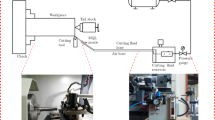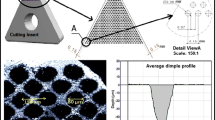Abstract
The significant amount of heat and friction generated in machining Ti-6Al-4V affects the cutting performance and results in serious problems such as severe tool wear and poor surface quality. Graphene oxide (GO) nanoparticles have excellent thermal conductivity and high lubrication capability and have emerged as a promising solution to the heat and tribology issues. As an additive material, GO nanoparticles mixed in base fluids may lead to significant increase in thermal conductivity and lubrication capability, which in turn, could result in smaller cutting forces and lower cutting temperature in the cutting zone. This paper presents new models of using GO nanofluids in turning processes which can accurately predict the change in cutting temperature and cutting forces. The cutting temperature model was created by considering the thermal conductivity and specific heat of the GO nanofluids along with their heat transfer coefficient and friction coefficient, whereas the cutting force model was developed by taking into account friction, tool geometry and the friction coefficient associated with the thermal properties of nanofluids.
Similar content being viewed by others
References
Altintas Y (2012) Manufacturing automation: metal cutting mechanics, machine tool vibrations, and CNC design. Cambridge university press, Cambridge
Liew PJ, Shaaroni A, Sidik NAC, Yan J (2017) An overview of current status of cutting fluids and cooling techniques of turning hard steel. Int J Heat Mass Transf 114:380–394
Li R, Huang Z, Wu X, Yan P, Dai X (2018) Cryogenic quenching of rock using liquid nitrogen as a coolant: investigation of surface effects. Int J Heat Mass Transf 119:446–459
Sundar LS, Singh MK, Sousa AC (2018) Turbulent heat transfer and friction factor of nanodiamond-nickel hybrid nanofluids flow in a tube: an experimental study. Int J Heat Mass Transf 117:223–234
Qin S, Li Z, Guo G, An Q, Chen M, Ming W (2016) Analysis of minimum quantity lubrication (MQL) for different coating tools during turning of TC11 titanium alloy. Materials 9(10):804
Yildiz Y, Nalbant M (2008) A review of cryogenic cooling in machining processes. Int J Mach Tools Manuf 48(9):947–964
Courbon C, Kramar D, Krajnik P, Pusavec F, Rech J, Kopac J (2009) Investigation of machining performance in high-pressure jet assisted turning of Inconel 718: an experimental study. Int J Mach Tools Manuf 49(14):1114–1125
Bordin A, Sartori S, Bruschi S, Ghiotti A (2017) Experimental investigation on the feasibility of dry and cryogenic machining as sustainable strategies when turning Ti6Al4V produced by additive manufacturing. J Clean Prod 142:4142–4151
Ahmed LS, Kumar MP (2016) Cryogenic drilling of Ti–6Al–4V alloy under liquid nitrogen cooling. Mater Manuf Process 31(7):951–959
Su Y, Gong L, Li B, Liu Z, Chen D (2016) Performance evaluation of nanofluid MQL with vegetable-based oil and ester oil as base fluids in turning. Int J Adv Manuf Technol 83(9–12):2083–2089
Elomaa O, Singh VK, Iyer A, Hakala TJ, Koskinen J (2015) Graphene oxide in water lubrication on diamond-like carbon vs. stainless steel high-load contacts. Diam Relat Mater 52:43–48
Chu B, Singh E, Samuel J, Koratkar N (2015) Graphene oxide colloidal suspensions as cutting fluids for micromachining—part I: fabrication and performance evaluation. J Micro Nano-Manuf 3(4):041002
Liang H, Bu Y, Zhang J, Cao Z, Liang A (2013) Graphene oxide film as solid lubricant. ACS Appl Mater Interfaces 5(13):6369–6375
Samuel J, Rafiee J, Dhiman P, Yu Z-Z, Koratkar N (2011) Graphene colloidal suspensions as high performance semi-synthetic metal-working fluids. J Phys Chem C 115(8):3410–3415
Yi S, Li G, Ding S, Mo J (2017) Performance and mechanisms of graphene oxide suspended cutting fluid in the drilling of titanium alloy Ti-6Al-4V. J Manuf Process 29:182–193
Cheng K (2008) Machining dynamics: fundamentals, applications and practices. Springer Science & Business Media
Cheng K, Luo X, Ward R, Holt R (2003) Modeling and simulation of the tool wear in nanometric cutting. Wear 255(7–12):1427–1432
Wang S, Clarens AF (2013) Analytical model of metalworking fluid penetration into the flank contact zone in orthogonal cutting. J Manuf Process 15(1):41–50
Childs T (2006) Friction modelling in metal cutting. Wear 260(3):310–318
Josyula SK, Narala SKR (2018) Study of TiC particle distribution in Al-MMCs using finite element modeling. Int J Mech Sci 141:341–358
Kus A, Isik Y, Cakir MC, Coşkun S, Özdemir K (2015) Thermocouple and infrared sensor-based measurement of temperature distribution in metal cutting. Sensors 15(1):1274–1291
Kim F, Cote LJ, Huang J (2010) Graphene oxide: surface activity and two-dimensional assembly. Adv Mater 22(17):1954–1958
Yu W, Xie H, Chen L, Li Y (2010) Enhancement of thermal conductivity of kerosene-based Fe3O4 nanofluids prepared via phase-transfer method. Colloids Surf A Physicochem Eng Asp 355(1–3):109–113
Abukhshim N, Mativenga P, Sheikh M (2006) Heat generation and temperature prediction in metal cutting: a review and implications for high speed machining. Int J Mach Tools Manuf 46(7):782–800
Brocail J, Watremez M, Dubar L (2010) Identification of a friction model for modelling of orthogonal cutting. Int J Mach Tools Manuf 50(9):807–814
Umbrello D, M’saoubi R, Outeiro J (2007) The influence of Johnson–Cook material constants on finite element simulation of machining of AISI 316L steel. Int J Mach Tools Manuf 47(3):462–470
Calamaz M, Coupard D, Girot F (2008) A new material model for 2D numerical simulation of serrated chip formation when machining titanium alloy Ti–6Al–4V. Int J Mach Tools Manuf 48(3–4):275–288
Colwell LV (1954) Predicting the angle of chip flow for single-point cutting tools. Trans ASME 76:199
Chen G, Ren C, Jin X, Guo T (2011) Experimental and finite element study of steady state micro-cutting characteristics of aluminum alloy (2A12). Trans Tianjin Univ 17(5):344–350
Acknowledgements
The authors acknowledge the facilities, and the scientific and technical assistance of the RMIT Microscopy & Microanalysis Facility (RMMF), a linked laboratory of Microscopy Australia. The authors would like to thank Mr. Mark Overend of the Advance Manufacturing Lab for his help in the experiments. The authors’ special thanks go to CSC (China Scholarship Council) for the scholarship (CSC Student ID: 201608240004).
Author information
Authors and Affiliations
Corresponding author
Additional information
Publisher’s note
Springer Nature remains neutral with regard to jurisdictional claims in published maps and institutional affiliations.
Rights and permissions
About this article
Cite this article
Yi, S., Li, N., Solanki, S. et al. Effects of graphene oxide nanofluids on cutting temperature and force in machining Ti-6Al-4V. Int J Adv Manuf Technol 103, 1481–1495 (2019). https://doi.org/10.1007/s00170-019-03625-1
Received:
Accepted:
Published:
Issue Date:
DOI: https://doi.org/10.1007/s00170-019-03625-1




